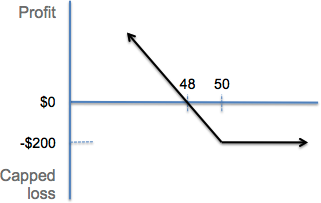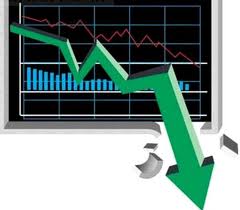What is a Put Option?
Put Option Examples
Related Terms:
- What are Call Options?
- How to Turn $4,000 into $20,000 with Options Trading
- Understanding Option Pricing
- Top 10 Option Trading Tips
- Best Option Brokers
Put Option Definition:
A put option is a security that you buy when you think the price of a stock or index is going to go down. More specifically, a put option is the right to SELL 100 shares of a stock or an index at a certain price by a certain date. That "certain price" is known as the strike price, and that "certain date" is known as the expiry or expiration date.
A put option, like a call option, is defined by the following 4 characteristics:
- There is an underlying stock or index to which the option relates
- There is an expiration date of the put option
- There is a strike price of the put option
- The put option is the right to SELL the underlying stock or index at the strike price. This contrasts with a call option which is the right to BUY the underlying stock or index at the strike price.
It is called an "put" because it gives you the right to "put", or sell, the stock or index to someone else. A put option differs from a call option in that a call is the right to buy the stock and the put is the right to sell the stock.
So, again, what is a put? Since put options are the right to sell, owning a put option allows you to lock in a minimum price for selling a stock. It is a "minimum selling price" because if the market price is higher than your strike price, then you would just sell the stock at the higher market price and not exercise it.
Trading Tip: Look at the graph at the lower right and note the shape of the payoff curve for owning a put option. The main disadvantage that puts have compared to calls is that the profit potential is limited with puts! For puts, the most that a stock price can go down to is $0 (think bankruptcy). So the most that a put option can ever be in the money is the value of the strike price.
This contrasts to calls, where the stock price theoretically can go to infinity so the profit potential from a call option is unlimited. This is one reason that puts have less appeal and less volume than calls; the other reason that puts typically have less volume than calls is that the natural trend of the market is up so most people are expecting stocks to go up so they buy calls.
Put Option Payoff Diagram

When to Buy a Put:
If you think a stock or index price is going to go down, then there are 3 ways you can profit from a falling stock price:
- you can short the stock or index
- you can write a call option on the stock, or
- you can buy a put option on the stock.
Put Option Example:
There are 3 different examples in which most people would buy puts.
Put Option Example #1--Speculation
The first example is if you believe that a stock price is going to fall in the near future. Maybe the stock has gone up too much too quickly. Or suppose you know that a stock is about to release bad earnings or report some other bad news. If this is the case, then you best way to make money in the short term is to just buy a put option on the stock.
Suppose you think Apple Computer (ticker symbol is AAPL) is overpriced at $700 a share AND you believe the stock will drop in the near future, you can buy put options on AAPL. The strike price and the expiration month that you choose depends on how far you think AAPL will drop and when you think it will drop.

Suppose it is February 1st, AAPL is at $700, and you know that AAPL earnings are to be released tomorrow. Also suppose you found out from a friend that knows for certain that the sales are down and profits are down. You can buy an AAPL February $690 put option for maybe $2 or $200 per contract (remember each option contract covers 100 shares so when you see the price at $2 that is a per share price and the option contract will cost $200). You would buy the nearest expiration month because that would be the cheapest, and you would buy the nearest strike price under the current market price because that is where you tend to get the greatest percentage return.
When the news comes out tomorrow that AAPL sales were terrible and the price of AAPL drops to $675 per share, then your AAPL $690 put option will be priced at $15 or more and you could sell it for $1,500 per contract and make a nice $1,300 profit! Why would it be worth at least $15? It is worth $15 because you now have the right to sell 100 shares of AAPL stock at $690 even thought the current market price is only $675. Your put option is in-the-money; $15 and the contract will be worth at least $1500.
Put Option Example #2--You Own the Stock and Expect a Temporary Drop in the Stock Price, But You Don't Want to Sell the Stock
Here's another example of why a lot of people trade put options. If you bought a 100 shares of Apple Computer (AAPL) at $50 many years ago and you are afraid the price might drop temporarily, yet you want to hold onto AAPL for the long term, you should buy a put option.
As in the example above, you can buy the AAPL $690 put for $200 and when AAPL is later at $665 you can sell your put for $35 or $3500 per contract. In this instance you still own the stock and have taken a similar loss on owning the stock, but that loss on the stock is offset 1:1 for the profit you made on the put option.
Put Option Trading Tip: Why buy a put option if you own the stock and you think the price will decline? Many people in this instance would just sell the stock, let it drop, and then buy the stock back at a lower price. The problem with this strategy is that you would have a huge capital gain on the sale of the stock and you would have to pay taxes on that gain. If you just buy a put, that is a totally different transaction as far as the IRS is concerned so you would just have to deal with the tax consequences of that put option trade.
So if you own stock at a very cheap cost basis and you think a stock price will decline for the short term, but you still want to hold onto it for the long term, then buy a put option!
The taxes on the put trade will be less than the taxes on the stock if you had purchased the stock at a very low price.
Put Option Example #3--Using Puts as Insurance
Suppose you bought 100 shares of AAPL at $500 but wanted to make sure you don't lose more than 10% on this investment. You could buy an AAPL put option with a strike of $450. That way if the price drops below $450 a share you will be able to exercise your put option and sell your stock for $450. Please note that you don't "HAVE TO" sell your AAPL shares at $450! If the price in the market is $475 then of course you can sell your shares in the market at $475. That is why it is called an option--it is a choice and not an obligation.
Of course in this example if the price of AAPL rose to $750 then your put would become worthless, but at least you had the protection (sometimes called insurance) in the event the stock price fell.
Put Option Trading Tip: In the U.S. most equity and index options expire on the 3rd Friday of the month, but now we are seeing the most actively traded stocks are allowing options that expire every week. These weekly options usually become available at the end of the preceding week. If you are just getting started trading options, then stay away from the weeklies as they are very volatile.

Here are the top 10 option concepts you should understand before making your first real trade: